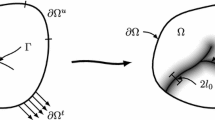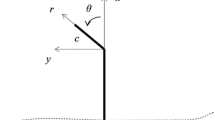Abstract
An analytical and numerical procedure based on an independent integral path and finite element analysis for mixed-mode fracture in viscoelastic orthotropic media is developed. The separated method employs virtual mechanics fields induced by the classical singular analytical forms. The viscoelastic generalization uses a thermodynamic approach by defining an energy release rate only taking into account a perfect uncoupling between free and viscous energies. The implementation of the Mθ-integral in finite element software and its integration into the viscoelastic incremental formulation are presented. As results, the analytical and numerical solutions are compared by the way of the energy release rate in pure mode I, pure mode II and mixed modes. In shows that, the developed model lead to accurate and efficient separated fracture mode in viscoelastic materials.
Similar content being viewed by others
References
Asadpoure A, Mohammadi S and Vafai A (2006). Modelling crack in orthotropic media using a coupled finite element and partition of unity methods. Finite Elem Anal Des 42: 1165–1175
Attigui M and Petit C (1997). Mixed-mode separation in dynamic fracture mechanics: new path independent integrals. Int J Fract 84: 19–36
Bui HD, Proix JM (1985) Découplage des modes mixtes de rupture en thermo-élasticité par des intégrales indépendantes du contour. Actes du Troisième Colloque Tendances Actuelles en Calcul de Structure, Bastia, pp 631–643
Charvet-Quemin F, Combescure A, Ebersol L, Charras Th, Millard A (1986). Méthode de calcul du taux de restitution de l’énergie en élastique et en non linéaire matériau. Report DEMT 86/438
Chazal C and Dubois F (2001). A new incremental formulation in the time domain of crack initiation in an orthotropic linearly viscoelastic solid. Mech Time-Depend Mat 5: 3–21
Chen FMK and Shield RT (1977). Conservation laws in elasticity of the J-integral type. J Appl Mech Phys 28: 1–22
Destuynder Ph, Djaoua M and Lescure S (1983). Quelques remarques sur la mécanique de la rupture élastique. J de Mécanique Théorique et Appliquée 2: 113–135
Dubois F, Petit C (1999) Découplage des modes de rupture dans le bois: approche numérique par l’intégraleMθ. Revue Française de Génie Civil, pp 247–257
Dubois F and Petit C (2005). Modelling of the crack growth initiation in viscoelastic media by the Gθ v -integral. Eng Fract Mech 72: 2821–2836
Dubois F, Chazal C and Petit C (1999). Modelling of crack growth initiation in a linear viscoelastic material. J Theor Appl Mech 37: 207–222
Dubois F, Chazal C and Petit C (2002). Viscoelastic crack growth process in wood timbers: an approach by the finite element method for mode I fracture. Int J Fract 113: 367–388
Ghazlan G, Caperaa S and Petit C (1995). An incremental formulation for the linear analysis of thin viscoelastic structures using generalized variables. Int J Numeric Methods Eng 38: 3315–33
Kim JH and Paulino GH (2002). Mixed-mode fracture of orthotropic functionally graded materials using finite elements and the modified crack closure method. Eng Fract Mech 69: 1557–1586
Nobile L, Piva A and Viola E (2004). On the inclined crack problem in an orthotropic medium under biaxial loading. Eng Fract Mech 71: 529–546
Noether E (1918). Invariant variations problem. Transport Theory Stat Phys 1: 183–207
Prabhu S and Lambros J (2002). Mixed mode asymptotic crack tip field in orthotropic materials: derivation and range of dominance. Int J Fract 118: 339–361
Richard HA and Benitz K (1983). A loading device for the creation of mixed mode in fracture mechanics. Int J Fract 22: R55–R58
Rice JR (1968). A path independent integral and the approximate analysis of strain concentrations by notches and cracks. J Appl Mech 35: 379–386
Sih GC (1974). Strain energy density factor applied to mixed mode crack problems. Int J Fract 10: 305–321
Staverman AJ and Schwarzl P (1952). Thermodynamics of viscoelastic behavior. Proc Acad Sci 55: 474–492
Stefanie E, Stanzl-Tschegg (2006) Microstructure and fracture mechanical response of wood. Int J Fract 139:495–508
Suo XG and Combescure A (1992). On the application of the Gθ method and its comparison with the Lorenzi’s approach. Nucl Eng Des 135: 207–224
Valentin G and Morlier P (1982). A criterion of crack propagation in timber. Matériaux et constructions 88: 291–298
Van der Put TACM (2007). A new fracture mechanics theory for orthotropic materials like wood. Eng Fract Mech 74: 771–781
Zhang XB, Ma S, Recho N and Li J (2006). Bifurcation and propagation of a mixed-mode crack in a ductile material. Eng Fract Mech 73: 1925–1939
Author information
Authors and Affiliations
Corresponding author
Rights and permissions
About this article
Cite this article
Pitti, R.M., Dubois, F., Petit, C. et al. Mixed mode fracture separation in viscoelastic orthotropic media: numerical and analytical approach by the Mθv -integral. Int J Fract 145, 181–193 (2007). https://doi.org/10.1007/s10704-007-9111-4
Received:
Accepted:
Published:
Issue Date:
DOI: https://doi.org/10.1007/s10704-007-9111-4




